Steven Pressfield's Blog, page 36
March 11, 2020
Between Books
Writers sometimes ask me, “What should I do between books?”
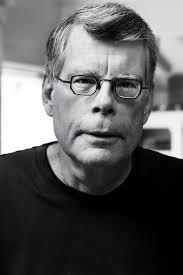
Stephen King writes every day, including his birthday and Christmas
My answer:
There should never be a “between books.”
Don’t stop.
Don’t blow your momentum.
Myself, I want to be ninety pages into the next book before I finish the one I’m working on now. My aim is to move seamlessly from one to the other. If I knock off Book #13 on Tuesday, I’m deep into the trenches on #14 Wednesday.
Why?
Resistance.
Resistance loves it when we stop working.
I have a friend at the gym who used to hang out with Jack Lalanne. He said Jack had a rule.
It’s okay if you skip a day working out. But on that day you’re not allowed to eat.
Jack had another axiom:
Every day you skip takes six days to make up.
Can that be true? I have no idea. But I know every day of writing we miss makes it that much harder when we come back.
Bail on three days and our writing muscles start going soft.
Skip a week and we’re falling behind the eight-ball.
Miss a month and it’s like starting over from scratch.
Stephen King writes three-sixty-five, including Christmas and his birthday.
Don’t stop.
There should be no “between books.”
March 4, 2020
Scuffling in Tinseltown
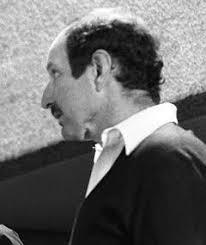
Ernie Pintoff
When I came out to Hollywood from New York, one of my first paying gigs was working on a low-budget action script with the director Ernie Pintoff. Ernie had actually won an Oscar (you can look it up) for a short subject called “The Critic” with Mel Brooks. But mostly he made his living doing episodic television.
Ernie and I would work at his house in Outpost Canyon. We sat side by side at a huge oak table in his kitchen. Sometimes we’d work for eight or ten hours at a crack. I’d drive home exhausted.
Ernie never spoke to me about anything except the movie we were writing. I wasn’t sure he even knew my name. But little by little we started getting to know each other. One day during a break he asked me what else I was doing when I wasn’t working for him. I told him I had written three novels that never got published—-and I was constantly hammering out spec screenplays that also didn’t sell. He regarded me thoughtfully for a long few seconds.
“Keep working,” he said.
I could tell this was a piece of serious wisdom from a veteran who had been through the wars, but I wasn’t really sure what Ernie meant.
The next day I asked him if he wouldn’t mind elaborating.
Again he said, “Just keep working.”
Then Ernie’s fiftieth birthday came around. His wife Caroline threw a big party and I helped out. When the event was over, Ernie and I wound up in the kitchen together doing the dishes. Ernie had recently been diagnosed with cancer. He had had cancer twice before and survived.
“Keep working,” he said. “Don’t turn anything down. Porn flicks, slasher movies, free stuff for friends. Don’t get precious. You’re young, you’re learning. Keep working.”
Ernie cited three reasons:
“One, working means you’re getting paid. I know you’re getting peanuts for this job. It doesn’t matter. It’s money, it’s validation. Every buck means you’re a working pro, you’re toiling in your chosen field.
“Two, when you work, you learn. Everybody has something to teach you. A grip will show you something about lighting, an editor will drop some pearl about what to keep and what to cut. Even actors know something.
“Three, you’re making friends. Some kid who’s schlepping coffee today may be a producer tomorrow. He may buy one of your specs. An actress you do some free work for today may get you hired for a rewrite six months from now.”
I was thinking, Does this movie we’re working on count?
Ernie read my mind. He laughed. “Don’t turn your nose up at anything. This piece of crap we’re working on now can teach you plenty. Because it’s working. The principles of story-telling are in this piece, just like in Shakespeare. I’m making sure they’re in there. Watch me. Do what I tell you. Porn works, splatter works, horror works; if they didn’t, nobody’d finance ‘em and nobody’d go to see ‘em. You can learn from all of them.”
There’s a sad ending to this story. Ernie died a few years later. Our little action movie never got made.
But I took a lot of jobs because of what Ernie told me, and I never regretted any of them. I learned my craft. I got to work as a pro. Ernie gave me the best advice I’ve ever gotten.
“Keep working.”
February 26, 2020
The Non-Zero Sum Character
We’ve been positing in our series on Villains in film and fiction that the Bad Guy as a general rule believes in a world of scarce resources, a cosmos in which all men and women are born selfish/evil … and that this condition—“the state of nature,” as Thomas Hobbes phrased it—produces inevitably a “war of all against all.”
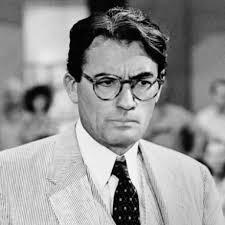
Gregory Peck as Atticus Finch in Harper Lee’s “To Kill a Mockingbird”
The villain in other words sees the universe as a zero-sum proposition, i.e. a world in which, if he is to gain, he must take away from you and me.
In this post let’s examine the opposite proposition.
Let’s consider the world and world-view of the villain’s antithesis—the Hero.
The hero, by my definition, is the character who is capable (though he may have to change radically through the course of our story to reach this position) of acting in a non-zero sum manner. In other words, acting not for herself alone, but out of love for another.
Here, in no particular order, is a sampling of real-life non-zero-sum characters.
Jesus of Nazareth
The 300 Spartans at Thermopylae
Joan of Arc
Abraham Lincoln
Mahatma Gandhi
Dr. Martin Luther King, Jr.
John F. Kennedy
Malcolm X
Robert Kennedy
John Lennon
Yitzhak Rabin
And a few from legend, fiction and motion pictures:
Odysseus
Beowulf
Atticus Finch
Huckleberry Finn
Celie in “The Color Purple”
Rick Blaine in “Casablanca”
Pike, Dutch, and the Gortch Brothers in “The Wild Bunch”
Captain Miller in “Saving Private Ryan”
Shane
Princess Leia
Luke Skywalker
If the Villain believes in a zero-sum world, the Hero believes in its opposite.
If the Villain believes in a universe of scarcity, the Hero believes, if not in a world of abundance, then at least in the possibility of such a world.
If the Villain believes in a reality dominated by fear, the Hero believes in one ruled by love.
The Villain is cynical. He or she believes that mankind is inherently evil.
The Villain believes in “reality,” in a Hobbesian world of all-against-all.
The Villain, as we’ve said, is not necessarily “bad” or even “villainous.” In the villain’s eyes, he is the Good Guy. He is simply acting and making choices within a universe of monsters. He must therefore become, in the name of Good (or at least self-preservation or the preservation of society as a whole) a monster himself.
The zero-sum view of life is that of limited resources. Not enough to go around. If you and I want our share (or even simply enough to survive), we must take it from somebody else. However much of the pie we grab, that’s how much less remains for everyone else.
In the non-zero-sum world, on the other hand, resources are infinite. The love a mother gives to her child (and that the child returns) grows greater, the more each loves. There is and can never be a shortage of love.
Compassion is infinite.
Integrity is infinite.
Faith is infinite.
Zero-sum versus non-zero-sum.
Hero versus Villain.
February 19, 2020
Kati’s Reply (and Mine)
I wanted to post Kati’s letter as soon as it came in because I felt certain that there would be a strong and passionate response. But the outpouring of support, encouragement, tough love, not to mention some pretty deep wisdom overwhelmed me. I think it overwhelmed Kati too.
My thanks to everyone who wrote in. The notes were so heartfelt and contained so much kindness and caring, it almost didn’t matter what specific “advice” or kicks-in-the-pants they contained. The gesture was everything.
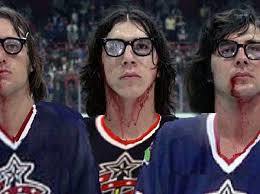
The Hansen Brothers from “Slap Shot.” Or is it you and me?
Kati responded right away, but because her reply appeared in the Comments section on the same day the original post ran, I’m afraid some people might have missed it.
So here’s Kati’s note to everyone who wrote in to her:
Hey all,
This is Kati who wrote the letter.
Thank you so much for all your comments!
I sent that email to Steven at 4 am, which, of course was a bad idea. I was totally fed up with everything and experienced a sudden need to just yell at the Universe. But there was no one up there, so I yelled at Steven instead, which was unfair, of course.
Unexpectedly Steven replied while I was still awake and said he wanted to publish my letter. Go ahead, I said, still mad.
(Btw, I am a Finn, from Finland. We are honest folks. When things go wrong, we say it. Out loud.).
I felt bad and so I said it. Out loud.
Was my feeling justified? Yes and no.
No because I live in a welfare state and have really nothing to worry about.
And yes because of course we all have the right to feel what we feel.
Maybe sharing these feelings in the internet is not such a great idea because our feelings change. Constantly. The state of mind I was on Wednesday, February 5th, at 4 am, is gone. But what is released into the world wide web stays, if not forever, for a very long time.
Do I regret I sent my email?
I don´t know. But if there is someone out there, reading these words, feeling lonely and lost, I just want to say: you are not walking this journey of trials alone. Because a journey of trials it is. And it is OK even if it sucks at times.
And when it sucks, go ahead and yell! You can yell at me! Steven has my email address.
At 4 am, last week Wednesday, while staring at the bedroom ceiling, I decided to write a book about failing. Because failure always comes at the heels of success. It is an essential part of creative endeavours. I know you are not supposed to use the f-word, but I dont care. I think it is healthy sometimes to look the devil in the eye and call it whatever you want to call it.
Is writing really a bad idea?
I guess it is a bad idea the same way having kids is a bad idea. Your heart will break and there will be tears and you are so tired all the time. And yet. There is also bliss. Unimaginable joy. Euphoria.
There is LIFE in all its twisted glory.
So please dont listen to me. Keep on writing, you guys – but not for success. Write to tell us your truth. Because we need to hear it. I need to hear it.
Don´t give up.
With love and blessings,
Kati
And here’s my own e-mail to Kati, after I asked her and she gave me permission to publish her letter in a Writing Wednesdays post.
I’ll publish your letter then, Kati. It’ll be very interesting to see how people respond. Of course yours is everybody’s nightmare scenario. It’s in everybody’s head all the time, whether they address it or try not to think about it.
My own answer is that of course the dream of making a living as a writer is a tremendous long shot. The odds are overwhelmingly against success, particularly today with Amazon and Google where, what, half a million new books are published every year?
To say we want to succeed financially in that jungle is like saying we want to be professional basketball players. It’s easier to become a brain surgeon. At least you can go to school for that.
That said, the idea of following one’s Muse is a lifelong enterprise, one that we are faithful to for its own sake and its own rewards and not for worldly success. That to me is not only an honorable and noble and admirable way to live but the ONLY way for many of us. I know it’s the only way for me. I couldn’t do anything else.
Are you familiar with Elizabeth Gilbert, the author of “Eat Pray Love” and other books? She has dealt with these internal issues in a very serious manner. She says that, at the start of her adventure into a writing career, she “made a deal” with her writing. She said, “I will never ask you to support me. I will always support you.”
She got lucky of course, and had a huge hit after not very long. But I like her attitude a lot. She said to herself, “I am a writer. That is my calling and I intend to follow it lifelong, whether it pays off financially or not.”
Krishna says in the Bhagavad-Gita that we have a right to our labor, but not to the fruits of our labor.
P.S. It probably helps too not to publish in Finnish with five million potential readers, rather than in English with a billion or so.
That’s my answer!
Steve
There’s a final thought I’d like to add. This is for our readers and for everyone who wrote in.
Sometimes when I’m writing these posts, I wonder if I’m crazy to keep doing them. Some posts will get three Comments, or four, or six. I find myself asking, Is anybody out there? Is any of this doing any good?
These answers to Kati made my day/week/month.
Thanks to everybody.
I think we may actually have a bit of a community here.
That’s what I was always hoping for.
Nobody said the path we’ve chosen is easy. As Freddy Mercury once sang, ” … it’s no bed of roses, no pleasure cruise.”
But there’s definitely consolation in all of us reaching out to “one of our own” with love and acceptance and encouragement.
And now, Kati, as my old mentor Paul Rink once told me,
“Start the next one tomorrow.”
February 12, 2020
“Writing is a Bad Idea”
I got this note a few days ago from a writer named Kati Reijonen. I have no prior acquaintance with Kati. In a raw and quite brave way, Kati’s letter expresses the “heart of darkness” that all of us as writers and artists carry around in our guts. With Kati’s permission I have reprinted the entire note below. If you like, please respond to Kati in the Comments section. I’d be very interested to hear what we all think. I’ll post the answer I sent to Kati next week.
Dear Pressfield and company,
I am a Finnish writer, just submitted my 3rd manuscript to the publisher.
I have been reading Steves blogs and also books. They are very encouraging and uplifting but I have to say I disagree with Steve.
Writing is not for everybody. It is really hard, lonely and above all, financially disasterous.
I am a great example of things gone wrong,
I left everything to pursue my dreams. I wanted to write and so I did. I got book deals. Great. But the fact of the matter is that writing doesn’t bring you income, particularly if you write in Finnish, only spoken by 5 million people.
So the situation is that at the age of 60, I am broke. I have spent whatever I had saved and owned to support myself while writing and its all gone now. I have no idea what to do next. Writing another book seems like a bad idea.
There are no jobs for a person my age in this country.
I would no recommend anyone to do what I did. I am stressed sick. Only the tough and resilient survive this. Others, like me, fall. And fail.
So here I am – a victim of the creative path so many self help writers recommend walking. I wish I hadn’t.
My Muse has left me. I guess I wasn’t worth hanging around with.
I feel sorry to have written this but what I have written is my truth. Failing is really hard, particularly when you are too tired to get up anymore…
I hope I am the only loser. I really do. I want everybody to succeed. Maybe I am just a sad exception…
Anyway, all the best to you,
Kati
Helsinki
Finland
February 5, 2020
Resistance = Fear
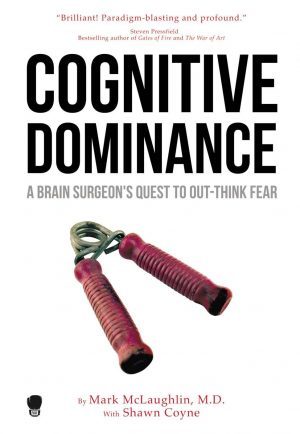
Get a Grip on Fear
Artists and warriors live and die by one primal emotion.
Fear.
Fear stops us from beginning our work. Or carrying it forward in the face of adversity. Or completing it when we’re so, so close.
Fear of success.
Fear of failure.
Fear of exposure.
Fear of venturing from the known (our conscious mind, our state as it currently exists) to the unknown (our unconscious mind, our work as we could make it if we had the courage.)
About a year ago, my biz partner Shawn Coyne told me he was working, with neurosurgeon Mark McLaughlin, on a book about fear.
My nervous system perked up immediately.
Shawn gave me the thirty-second pitch.
Have you ever thought about the fear that a neurosurgeon faces when something goes wrong? While cutting open or delicately tweaking somebody’s brain? One false move and the surgeon can kill or permanently disable the innocent and helpless patient on the operating table—perhaps a young child. The surgeon, under life and death conditions (which may require critical decisions in microseconds), must act in the face of often-near-paralyzing uncertainty and fear.
How does one do this? Apparently it’s not a subject that’s taught in medical school.
The individual surgeon, Mark McLaughlin says, has to develop their own method.
That’s what Shawn and Mark’s book is about.
They call it Cognitive Dominance: A Brain Surgeon’s Quest to Out-think Fear.
Cognitive meaning “of knowing … of awareness.” Dominance meaning “the capacity to act with deliberation and power … to ascertain the right response to an emergency and to implement it.”
What came out of Mark McLaughlin’s exploration of his own mental (and emotional) process in the face of fear is an entire life-encapsulating philosophy—and one that applies directly to you and me as writers and artists.
Fear is good.
Fear, Mark McLaughlin says, forces us to pay attention. It compels us to decide and to act in the face of extremity. Fear is a survival mechanism. Fear is primal, ancient, inescapable.
Cognitive Dominance is a Big Idea book wrapped inside of a memoir about a guy trying to get out from under a very traumatic event that threatened his career and very sanity.
Full disclosure: Cognitive Dominance can get a little wonky. Shawn and Mark get deep, deep into the weeds. I love that. The model of the universe that they evolve is as detailed as a Special Forces operational order and as profound as a treatise from the Kaballah. I recommend it at the five-star level.
Plus right now we are running a deal where you can get the paperback and the ebook at a discounted price.
Here’s the Black Irish link for more information.
Or from Amazon.
January 29, 2020
Our Michael Moment
Every great second act has a midpoint. In this instant something happens that ratchets our entire story to a higher level. The stakes go up, way up.
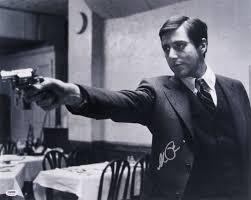
“But if Clemenza can figure a way to have a weapon planted there for me … then I’ll kill them both.”
Characters whom we thought we understood must suddenly be viewed in an entirely different, and far more serious, manner. The story upshifts. Every relationship in the narrative alters. Until this moment, we had thought the drama was about “X.” At once we understand it’s about “X squared.”
MICHAEL
They want to have a meeting with me, right? It’ll be me, McCluskey and Sollozzo. Let’s set the meeting. Get our informers to find out where it’s going to be held. Now we insist it’s a public place, a bar, a restaurant, some place where there’s people so I feel safe. They’re going to search me when I first meet them, right? So I can’t have a weapon on me then. But if Clemenza can figure a way to have a weapon planted there for me … then I’ll kill them both.
This speech from Michael Corleone (Al Pacino) is the midpoint of The Godfather. If it ain’t Shakespeare, it’s pretty damn close.
Consider what happens in this moment.
Up to this juncture in the story, Michael has been at best a minor helper in the emergency that is engulfing the Corleone family. His quick thinking has saved his father the Don (Marlon Brando) at the hospital, but otherwise his brother Sonny (James Caan) and the capos have tried to protect Michael and keep him out of the central action. Recall that, at this point in the story, Michael is still in essence a civilian—a Marine Corps captain freshly home from WWII, with an innocent, non-family fiancee, Kate (Diane Keaton), with whom he intends to make a life outside of the Mob and its business.
That’s how we—and all the characters in the movie—perceive Michael at the start of this scene.
By the scene’s finish, sixty seconds later, every assumption has been overturned. We realize that Michael is the hero of this drama. The Godfather is his story, not the Don’s, and he will turn out to be the rightful (and only possible) heir to his father’s empire.
Director Francis Ford Coppolla shoots this speech in one slow “move-in.” Where does he position Michael? Not on a sofa or standing or sitting in a common chair.
Michael sits in the Don’s chair. The camera pushes in … in … in until the frame contains nothing but Michael as he pronounces, “Then I’ll kill them both.”
When you and I as writers enter the Belly of the Beast of our Second Act, we need to know what that “Michael moment” is for our story.
We have to ask ourselves,
What must happen in my story that will raise the stakes dramatically, change the dynamics between all my principal characters, and make the drama suddenly become about a deeper, more profound version of the conflict as I’ve presented it so far?
Knowing we must have a midpoint—and what changes that midpoint must deliver—will help us enormously when we encounter the despair of Act Two, the writer’s struggle as she enters the Belly of the Beast.
January 22, 2020
Glaukos and Sarpedon
[I’m starting (actually I started it a couple of weeks ago) an informal series on Instagram, where I will be recommending books on leadership—primarily military but also corporate, nonprofit, and so forth. The first book, inevitably, will be the Iliad. Doing some preliminary research I stumbled onto this post from nine years ago, before we were even doing “Writing Wednesdays.” I bring it back today, just for the literary greatness of the passages quoted from Homer. I hope our readers judge it worth their time and attention.]
Was there a greater war story, ever, than Homer’s Iliad? It’s almost a crime to call the Iliad a war story, by so many magnitudes does it transcend that and every other genre. What works of literature stand beside it? The Bible. The Bhagavad-Gita. The collected works of Shakespeare. Not much else.

The death of Sarpedon, from the Euphronios krater, 515 B.C.
I took a full-semester course in the Iliad in college. I got a D. I wish I could take that class over, because, after a few decades in the trenches of the storytelling craft, I’ve acquired a keen appreciation for the challenges that Homer faced in conceiving and composing this epic—and for how masterfully he solved them.
Today let’s consider one item only: minor characters.
The architecture of the Iliad has heroes stacked in tiers, if you’ll forgive a term from this season’s presidential debate coverage. As Homer’s champions duel each other before the walls of Troy, third-tier heroes (Agenor, Teukros, Antiphos) fall to second-tier heroes (Odysseus, Diomedes, Aeneas), who in turn are slain or bested in other ways by first-tier heroes (Hector, Achilles).
Glaukos and Sarpedon are third-tier heroes, but look at the speeches that Homer gives them (translation by Richmond Lattimore):
SARPEDON: Glaukos, why is it you and I are honored with pride of place, the choice meats and the filled wine-cups in Lykia, and all men look on us as if we were immortals, and we are appointed a great piece of land by the banks of the Xanthos, good land, orchard and vineyard, and ploughland for the planting of wheat? Therefore it is our duty in the forefront of the Lykians to take our stand and bear our part of the blazing of battle, so that a man of the close-armoured Lykians may say of us, “Indeed these are no ignoble men who are lords of Lykia, these kings of ours, who feed upon the fat sheep appointed and drink the exquisite sweet wine, since indeed there is strength of valour in them, since they fight in the forefront of the Lykians.”
Sarpedon was the son of Zeus and Laodameia; he and Glaukos were princes of the country of Lykia in Asia Minor. They were allies of the Trojans; they had rallied to the aid of Priam and fought beside Hector in defense of Troy. The root glauk- in Greek means “gray,” thus “Glaukos” means “gray-eyed.” Here is that hero, on the battlefield, answering the challenge of the Greek champion Diomedes:
GLAUKOS: High-hearted son of Tydeus, why ask of my generation? As is the generation of leaves, so is that of humanity. The wind scatters the leaves on the ground, but the live timber burgeons with leaves again in the season of spring returning. So one generation of men will grow while another dies. [Glaukos goes on to cite his descent from Bellerophon, who among other feats captured and tamed the winged horse Pegasus and rode him when he slew the monster Chimera]. But Hippolochos begot me … sent me to Troy and urged upon me repeated injunctions, to be always among the bravest, and hold my head above others, not shaming the generation of my fathers, who were the greatest men in Ephyre and again in wide Lykia.
Sarpedon, in the end, would be slain by Patroklos, prompting Hektor to enter the fray to save his ally’s corpse from being dishonored. The death of Patroklos at Hector’s hands brings Achilles at last back into battle and leads to the climactic clash between him and the Trojan champion that would seal the fate of Troy.
But, presaging this several books earlier, Homer gives Sarpedon this brief speech, addressed again to his dear friend Glaukos, which, in brilliant economy, sums up the warrior code of the Iliad’s Age of Heroes:
SARPEDON: Man, supposing you and I, escaping this battle, would be able to live on forever, ageless, immortal, so neither would I myself go on fighting in the foremost nor would I urge you into the fighting where men win glory. But now, seeing that the spirits of death stand close about us in their thousands, no man can turn aside nor escape them, let us go on and win glory for ourselves, or yield it to others.
January 15, 2020
Art is Real
When I had reached the depths of my own hero’s journey, living in an abandoned cinder-block house with no doors or windows, no electricity, no bathroom and no running water, I found that my requirements in reading material had altered dramatically.
I couldn’t read even good books, from outstanding authors, books I had read and loved in the past.
They didn’t work for me any more.
They felt shallow.
They didn’t give me what I needed.
The only works I could read were Homer, Shakespeare and the King James Bible.
I loved these. I would crack the Old or New Testament at random, not seeking anything “religious,” just for the poetry. Within three verses I’d be weeping.
And Ruth said to Naomi, Entreat me not to leave thee, or to refrain from following after thee. For whither thou goest, I will go; where thou lodgest, I will lodge; thy people shall be my people, and thy God my God. Where thou diest, I will die, and there shall I be buried. The Lord do so to me, and more also, if aught but death part thee and me.
That was when I became a believer in Art. I was deep in my own myth. I needed help. Only real myth could sustain me. But once I found it, I recognized it—and it did sustain me when nothing else could.
It was clear to me, then, that my heart and my journey were no different from those of every soul throughout history, male and female, who had made this passage before me. Some few of these, artists, inspired by who knows what, had managed to leave a sign for us who followed, a blaze on a tree, three stones piled up beside the trail. God bless them. They saved my life.
No one can ever tell me that art is trivial, or mere diversion or entertainment. The real stuff is mother’s milk. We can’t live without it. It guides us and sustains us.
It’s my religion.
January 8, 2020
Your Hero’s Journey and Mine
I’m from the Northeast. But my hero’s journey played out in the South. My family is middle-class, but my journey was strictly blue-collar. Why? Something impelled me to that part of the country and that stratum of society.
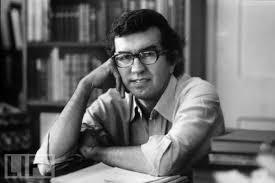
Larry McMurtry has said he thinks of himself as a herder of words, across a prairie of pages
I drove tractor-trailers, I worked on oil rigs, I picked fruit as a migrant laborer; I lived in hellholes without electricity and running water; my friends were mechanics and roustabouts and body-and-fender men. Why? Had I been in control of my journey, I could have selected any one of hundreds of other places and people and odysseys. Something made me choose this one. What? I had no idea. I didn’t even know that choice was involved. Something simply compelled me.
The hero’s journey is a metaphor for our artist’s life-to-be. It’s a foreshadowing, an adumbration of the Artist’s Journey to come. The passages are parallels. One prefigures the other.
Before my hero’s journey, I couldn’t write. After, I could. I write like a truck driver. The virtues that sustain me are blue-collar virtues, Southern virtues, workingman’s virtues. Everything I learned on my passage that I thought was useless has proved to be fundamental, indispensable.
Larry McMurtry says that he thinks of himself as a cattle driver of stories. He herds words across a prairie of pages. I like that.
Have you ever seen the video of Ana Forrest, the yoga instructor, doing unbelievable stuff in a handstand? Ms. Forrest, I understand, was a drug addict. There’s a connection. The dark, criminal, single-minded focus that the addict needs to survive (her hero’s journey) becomes the disciplined, single-minded will to master her own body and to surrender to the imperatives of her art.
Listen: no matter how crazy or down or preposterous your current state, it remains a passage toward the light. If it wasn’t, it wouldn’t feel crazy.
Trust me. When the lights come on in the darkroom, what looks to you now like a negative will develop into the photo you’ve been searching for all along—a photograph of yourself.



